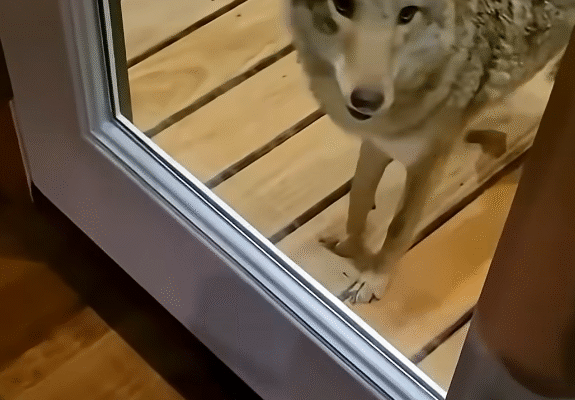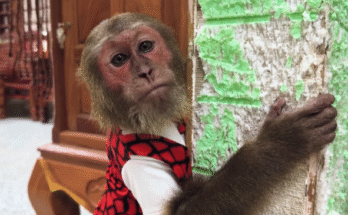It was a crisp autumn morning when James Carter, an avid hiker and nature lover, set out on his usual weekend trek through the woods. The air was fresh with the scent of pine, and the forest was alive with the sound of birds calling from the treetops. James had always found peace in these quiet trails, away from the chaos of the city. However, on this particular day, something unusual caught his attention—a faint, pitiful whimper coming from deeper within the trees.
Curious and concerned, James followed the sound. As he carefully pushed through a thick patch of bushes, he stumbled upon a heartbreaking sight: a young coyote, trapped in a cruel hunter’s snare. The animal’s fur was matted with dirt, and its leg was tightly bound by the metal wire, cutting into its flesh. Every time the coyote tried to move, the wire tightened, causing the animal to yelp in pain. James’s heart sank. He knew he had to do something—and fast.

A Race Against Fear and Time
Approaching a wild animal, especially one in distress, is no easy task. Coyotes, like most wild creatures, are naturally fearful of humans, and this one was no different. As James moved closer, the coyote bared its teeth and let out a warning growl. It was frightened, cornered, and in pain. James knew that if he made one wrong move, he could get bitten.
He spoke softly to the animal, trying to calm it down. “Easy there, buddy. I’m here to help you,” he whispered, keeping his voice gentle and steady. He pulled out his pocketknife, assessing the snare. The metal wire was twisted tightly around the coyote’s leg, and the animal’s struggle had only made things worse.

James realized he needed something more than just his knife. He quickly searched his backpack and found an old T-shirt. He wrapped it around the coyote’s head to shield its eyes and calm it, hoping the darkness would make it less anxious. With trembling hands, he began carefully cutting the wire, making sure not to injure the animal further. The coyote flinched and growled occasionally, but James stayed patient, murmuring words of comfort as he worked.
After what felt like an eternity, the last piece of wire snapped loose. The coyote’s leg was free, but it was bleeding and swollen. James stepped back cautiously, giving the animal space. To his surprise, instead of bolting away, the coyote remained on the ground, panting heavily. It was too weak to run.
The Decision
James knew he couldn’t leave the animal there. A wounded coyote had little chance of survival in the wild, especially with an injured leg. But what could he do? Wildlife rescue centers were miles away, and he didn’t have a vehicle nearby. For a moment, he considered calling animal control, but he worried they might put the coyote down, thinking it was too injured or dangerous.
In that moment, James made a decision that would change both their lives—he would take the coyote with him and care for it until it healed. It was a bold and risky choice, but James’s compassion outweighed his fear.
He carefully bundled the animal in his T-shirt, cradling it like a wounded dog, and began the long walk back to his car. The coyote didn’t fight him; perhaps it sensed that James was trying to help. Every step of the way, James reassured it. “Hang in there, buddy. We’ll get you fixed up,” he said softly.

Nursing the Wild Back to Health
Once home, James set up a makeshift bed for the coyote in his garage, which was warm and quiet. He researched online how to safely care for an injured wild animal. Using antiseptic and bandages, he cleaned the wound and wrapped the leg. He made sure not to feed it anything harmful, sticking to raw meat and water to mimic its natural diet.
The first few days were challenging. The coyote was wary of James, watching his every move with sharp, golden eyes. It refused to eat at first, too stressed from the ordeal. But James was patient. He sat nearby for hours, talking softly, giving the animal space, and slowly earning its trust.
By the end of the first week, the coyote—whom James had started calling “Rusty” because of its reddish fur—was eating small portions of meat and drinking water. Its leg began to heal, though James knew the animal would need weeks to fully recover.
A Bond Begins to Form
Over the next month, James and Rusty developed an unexpected bond. Every morning, James would check on Rusty before going to work, and every evening, he would sit in the garage, reading or just talking to the animal. Rusty’s wild spirit was still there, but he no longer growled when James approached. Instead, he watched with curiosity, his ears perking up whenever James spoke.
Sometimes, James wondered if he was doing the right thing. Wild animals weren’t meant to live with humans, and he knew Rusty couldn’t stay forever. His goal was always to help the coyote recover and then release it back into its natural habitat. But part of him worried—after weeks of care, would Rusty still be able to survive on his own?
Preparing for Release
By the sixth week, Rusty’s leg had healed significantly. He was stronger, eating well, and even showing signs of playfulness, occasionally pawing at the ground or sniffing around the garage. James knew the time was coming to say goodbye.
He contacted a local wildlife expert for advice. The expert applauded James’s efforts but reminded him that coyotes were wild by nature and needed to return to their natural environment. With a heavy heart, James prepared for Rusty’s release.
One sunny afternoon, James loaded Rusty into a large crate and drove back to the same forest where he had found him. As he opened the crate, Rusty hesitated for a moment, glancing back at James as if to say thank you. Then, with a burst of energy, the coyote dashed into the woods, disappearing into the trees.
The Lasting Impact
James stood there for a long while, watching the forest where Rusty had vanished. He felt a mix of sadness and pride. He had saved a life, and though he would miss the animal, he knew he had done the right thing.
That experience changed James in ways he never expected. He became more involved in local wildlife conservation efforts, volunteering with organizations that worked to protect wild animals and prevent harmful trapping. He also started sharing his story, hoping to inspire others to treat animals with compassion and respect.
Rusty, the wild coyote who had once been a frightened creature caught in a cruel snare, had left an indelible mark on James’s heart. Every time James hiked those forest trails, he would sometimes spot a flash of reddish fur in the distance and wonder—was that Rusty, living free and strong?



